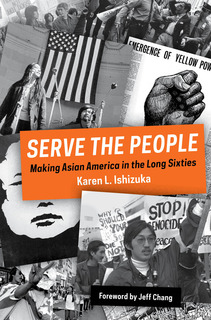Serve the People: Making Asian America in the Long Sixties highlights the stories and voices of activists who spearheaded the Asian American movement of the 1960s. Complicated, multi-pronged, and geographically diverse, the movement marked a profound political and social shift for Asian America, indeed, its very existence as a concept. Written by Karen Ishizuka, herself a member of the movement if not in her own words a pioneer, Serve the People offers a full narrative. It ranges from differing reasons why individuals became politically aware and active to community programs, political organizing, and arts, and ends with reflections and perspectives on those who participated in the Asian American movement and what this history means for our future.
Drawing extensively from her own interviews, Ishizuka tries to provide an inside view of the movement and its participants. Personal stories are central, though historical context and broader commentary weave throughout as well. The end result is a bit of a hodgepodge. If perhaps disorganized, the content at its core remains compelling for any interested in political activism and the Asian American movement.
One of the first things that struck me was the use of ‘we.’ Ishizuka, who’s own story is as much of the movement as those she writes of explains that this has long been the voice of the Asian American movement, communal at its heart. And it is the language her interviewees used over and over. The introduction lays out the books intent succinctly, acknowledging its place among the small selection of already existing publications on this movement. Ishizuka explains her focus on the lived experience:
I asked them to share personal discoveries and experiences that led to their intervention in history as contributors to social change, believing that the makers of history are often the best historians. . . Together, their discoveries, activism and reflections are symbolic of our generation of political cohorts as a whole.
The personal stories embedded on every page provide depth and an important addition to the historical wide angle. However, my major criticism is that I wish there had been more of the personal stories and excerpts from her interviews and fewer expert voices. Ishizuka frequently includes short quotes from experts, academics, and the like discussing some of the same issues she’s covering. And while I respect the desire to give intellectual credit where due, when you get to the point of ten names splattered across a page spread, it becomes distracting and hard to follow.
The insight of actors across the nation who brought rise to the Asian American movement make this book potent. They provide useful perspective into the motivations that gave rise to the era’s collective energy and lessons of a sort for today — for thinking about how activism might learn from the successes and failures of an earlier generation. It is Ishizuka’s project to capture a generation of voices that I ultimately find important and worthwhile, and am less impressed by the structure and writing of the book itself.









